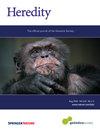在非洲爪蟾(Xenopus pygmaeus)中的FISH图谱改进了对基因组重排的理解,揭示了非洲爪蛙跳跃的NORs。
IF 3.9
2区 生物学
Q2 ECOLOGY
引用次数: 0
摘要
染色体重排是导致基因组多样化的基本进化驱动因素。非洲爪蛙(爪蟾属、爪蟾亚属和爪蟾亚属)是一种染色体数目保守的异源多倍体模式系统。已经确定了两个重要的染色体间重排:染色体9和2之间的易位,发现于Silurana亚属,染色体9和10之间的融合,可能广泛存在于爪蟾亚属。本研究利用染色体测量和荧光原位杂交(FISH)技术对异源四倍体pygmaeus (Xenopus)进行了深入的核型分析。我们设计了FISH探针来检测与易位和融合相关的基因,以检测两种主要重排的存在。我们还研究了5S和28S核糖体串联重复序列的位置,前者通常与端粒区有关,后者与核仁组织区(NORs)有关。易位相关的基因定位没有检测到X. pygmaeus的易位,支持易位仅限于Silurana的假设,而是在2S染色体上发现了一个中心点周围反转。融合相关的基因定位证实了9号和10号染色体的融合,支持这种融合是非洲爪蟾亚属的祖先状态。正如预期的那样,5S重复序列主要出现在几乎所有染色体的端粒区域。核仁28S重复序列定位在6S染色体上,这一位置以前只在近亲物种X. parafraseri中发现,而在其他系统发育上更远的物种中,NORs位于不同的染色体上。因此,我们假设跳跃机制可以解释爪蟾进化过程中NORs位置的相对频繁变化。本文章由计算机程序翻译,如有差异,请以英文原文为准。

FISH mapping in Xenopus pygmaeus refines understanding of genomic rearrangements and reveals jumping NORs in African clawed frogs
Chromosomal rearrangements are fundamental evolutionary drivers leading to genomic diversification. African clawed frogs (genus Xenopus, subgenera Silurana and Xenopus) represent an allopolyploid model system with conserved chromosome numbers in species with the same ploidy within each subgenus. Two significant interchromosomal rearrangements have been identified: a translocation between chromosomes 9 and 2, found in subgenus Silurana, and a fusion between chromosomes 9 and 10, probably widespread in subgenus Xenopus. Here, we study the allotetraploid Xenopus pygmaeus (subgenus Xenopus) based on in-depth karyotype analysis using chromosome measurements and fluorescent in situ hybridization (FISH). We designed FISH probes for genes associated with translocation and fusion to test for the presence of the two main types of rearrangements. We also examined the locations of 5S and 28S ribosomal tandem repeats, with the former often associated with telomeric regions and the latter with nucleolus organizer regions (NORs). The translocation-associated gene mapping did not detect the translocation in X. pygmaeus, supporting the hypothesis that the translocation is restricted to Silurana, but instead identified a pericentromeric inversion on chromosome 2S. The fusion-associated gene mapping confirmed the fusion of chromosomes 9 and 10, supporting this fusion as an ancestral state in subgenus Xenopus. As expected, the 5S repeats were found predominantly in telomere regions on almost all chromosomes. The nucleolar 28S repeats were localized on chromosome 6S, a position previously found only in the closely related species X. parafraseri, whereas other, phylogenetically more distant species have NORs located on different chromosomes. We therefore hypothesize that a jumping mechanism could explain the relatively frequent changes in the location of NORs during Xenopus evolution.
求助全文
通过发布文献求助,成功后即可免费获取论文全文。
去求助
来源期刊

Heredity
生物-进化生物学
CiteScore
7.50
自引率
2.60%
发文量
84
审稿时长
4-8 weeks
期刊介绍:
Heredity is the official journal of the Genetics Society. It covers a broad range of topics within the field of genetics and therefore papers must address conceptual or applied issues of interest to the journal''s wide readership
 求助内容:
求助内容: 应助结果提醒方式:
应助结果提醒方式:


